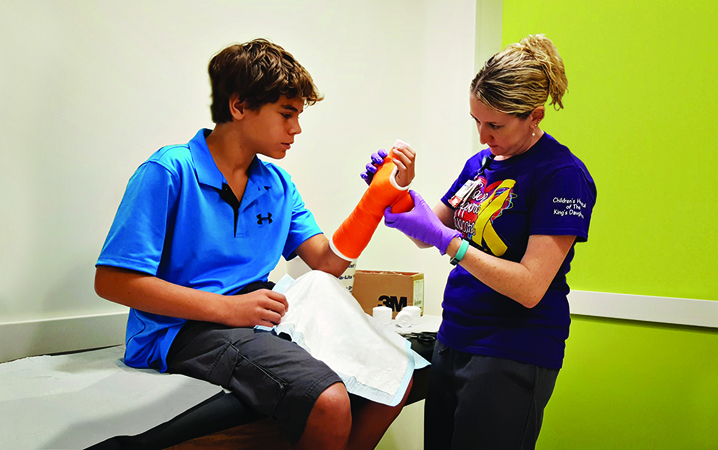
Lucky Breaks
Amanda Shockey, a registered nurse and certified athletic trainer with CHKD's orthopedic and sports medicine practice, puts the finishing touches on William Lowe's orange cast - one of eight colors children can choose from at CHKD casting clinics.
Eleven-year-old William Lowe may not feel lucky today, but he just got good news. Dr. Carl St. Remy, a pediatric orthopedic surgeon at CHKD, examined William’s broken thumb and determined that his growth plate was not damaged. William would not need surgery – just a cast for about six weeks.
Active kids and teens are at the highest risk for injury to bones and joints and vulnerable to unique injuries involving the growth plates of a bone, which can occur in as many as 30 percent of childhood fractures. Growth plates are made of cartilage and produce new bone material that hardens as a child grows. They are also the weakest part of the growing skeleton and especially susceptible to injury.
“Children’s bones are different than adults, and treating the injured bone correctly and promptly is important because kids heal so quickly,” says Dr. St. Remy. CHKD’s pediatric orthopedic surgeons specialize in the care of still-growing bones and evaluate thousands of broken bones in young patients at six locations throughout Hampton Roads each year. “A break on the growth plate can affect a bone’s development and cause lifelong health problems if not treated properly.”
Falls cause most broken bones in children, followed by competitive sports activities. This was true in William’s case – he broke both the bones in his lower left arm after falling from a playground structure when he was 6 years old and fractured a bone in his right arm jumping from a tree fort a year later. Both times, William avoided damage to his growth plates, and Dr. St. Remy was able to treat him with casting for six to eight weeks.
William’s most recent break happened during a soccer game, where he sustained a fracture to the base of his thumb near the growth plate. This time, he visited Dr. St. Remy at the CHKD orthopedic and sports medicine clinic at the new Health Center at Landstown, which also houses lab and radiology services, sports medicine physical therapy and sports medicine primary care, along with other specialty clinics.
“William is an active kid, and these kinds of breaks are not unusual,” says Dr. St. Remy. Boys are twice as likely to injure their growth plates, and their bones don’t fully mature until as late as 17 years old. “So far, he’s been pretty lucky.”
Does William consider them lucky breaks? Ask him again in six weeks when the cast comes off.